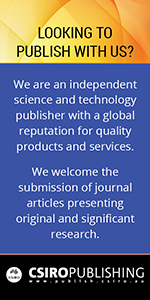
Australian Journal of Chemistry
Volume 70 Number 9 2017
RESEARCH FRONT: Dedication to Professor Alan Bond
CHv70n9_FOCelebrating Professor Alan Bond’s 70th Birthday
The foreword to this research front dedicated to Professor Alan Bond provides an account of his distinguished career in inorganic and electroanalytical chemistry in Australia and overseas, and also describes his many awards and achievements.
CH17262Controlling Grafting from Aryldiazonium Salts: A Review of Methods for the Preparation of Monolayers
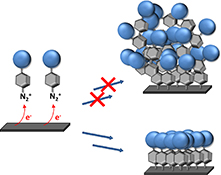
Grafting from aryldiazonium salts is a popular method for preparing strongly adherent organic coatings on many surfaces. Usually, the coatings are loosely packed disordered multilayers; however, over the past decade, strategies have emerged for generating monolayers. This review describes these approaches, illustrates some of their applications, and highlights the advantages and disadvantages of each.
CH17187Transformation of Cadmium Tetracyanoquinodimethane (TCNQ) into a Cadmium Terephthalate Metal–Organic Framework
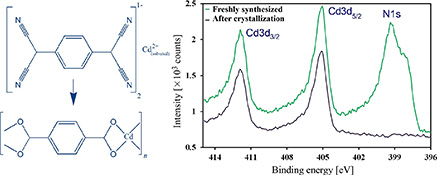
Aerial oxidation of Cd(TCNQ)2 during slow recrystallization in tetrahydrofuran produced a dicarboxylate ligand–Cd complex, with the N 1s XPS spectrum showing that this chemical transformation is complete.
CH17191A Potentiometric Sensor for pH Monitoring with an Integrated Electrochromic Readout on Paper
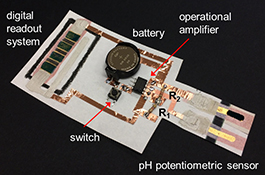
An integrated device is developed that incorporates a sensor, readout system, and battery on paper. The electrochromic readout system allows the pH range of a sample solution to be determined visually rather than using an LCD display or voltmeter. The integrated potentiometric sensor and readout system provides a cost-effective and lightweight solution for pH monitoring.
CH17258Electropolymerisation of N-Ethylanilinium Trifluoroacetate Ionic Liquid into Poly(N-Ethylaniline) and Control of its Morphology
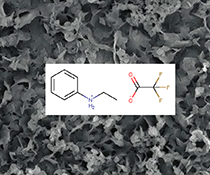
The electropolymerisation of N-ethylanilinium trifluoroacetate, a protic ionic liquid (PIL), was carried out, where the PIL served as the monomer precursor, solvent, and supporting electrolyte for the polymerisation process resulting in different morphologies, a greener approach to production, and a highly processable polymer.
CH17241Limitations in Electrochemical Determination of Mass-Transport Parameters: Implications for Quantification of Electrode Kinetics Using Data Optimisation Methods
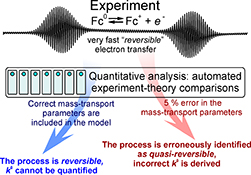
Electrochemical determination of mass-transport parameters is often subject to small errors, which influence the outcomes of voltammetric experiment–theory comparisons. In particular, a perilous situation emerges when a quasi-reversible model with slightly overestimated mass-transport parameters is used to quantify the electrode kinetics for a system that approaches a reversible limit.
CH17245Structural, Spectroscopic, and Electrochemical Characterization of Semi-Conducting, Solvated [Pt(NH3)4](TCNQ)2·(DMF)2 and Non-Solvated [Pt(NH3)4](TCNQ)2
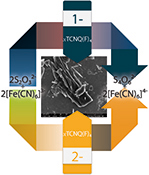
Two related [Pt(NH3)4]2+ complexes, [Pt(NH3)4](TCNQ)2·(DMF)2 (1) and [Pt(NH3)4](TCNQ)2 (2) are characterized using X-ray, electrochemistry, vibrational, and electronic spectroscopy. Unexpectedly, 2 is not a catalyst for the redox reaction of ferricyanide and thiosulfate, and the rationale for this is presented.
CH17256Electrochemical Oxidation of W(CO)4(LL): Generation, Characterization, and Reactivity of [W(CO)4(LL)]+ (LL=α-diimine ligands)
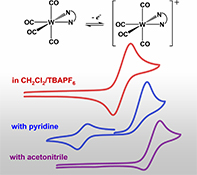
Oxidations of W(CO)4(LL) compounds were investigated electrochemically. The electrogenerated radical cations are unstable toward disproportionation, carbon monoxide substitution, and nucleophilic attack. The kinetics of these reactions were examined using a number of techniques including a.c. voltammetry and chronocoulometry. Infrared spectroelectrochemistry was used to characterize two [W(CO)4(LL)]+ species.
CH17218Correlation of Impedance and Effective Electrode Area of Iridium Oxide Neural Electrodes
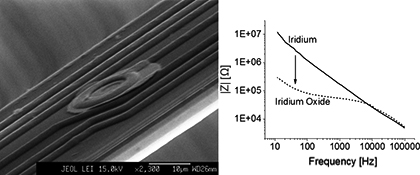
The electrical impedance of anodically formed iridium oxide is assessed and correlated with the effective electrode area and charge density for bionics applications.
CH17281Zinc Electrodeposition in the Presence of an Aqueous Electrolyte Containing 1-Ethylpyridinium Bromide: Unexpected Oddities
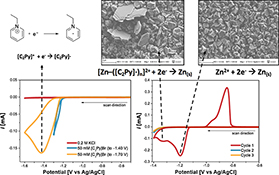
The generation of a radical species from the reduction of 1-ethylpyridiniuim bromide has been shown to passivate Zn/ZnII redox after one cycle. Both deposition morphology and nucleation process are also altered in the presence of the radical species.
CH17141Polymorphs of Neutral Red, a Redox-Mediating Phenazine in Biological Systems
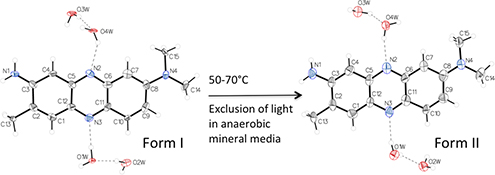
Crystalline neutral red accelerates microbial methane generation from coal. Industrial scale-up requires knowledge of crystalline polymorphs that may behave differently with methanogens. Temperatures in the dark, subterranean environments where methanogenesis occurs range from 50–70°C, conditions where neutral red crystallises or transforms to a new polymorph.
CH17089MoO2 Formed on Mesoporous Graphene Oxide: Efficient and Stable Catalyst for Epoxidation of Olefins
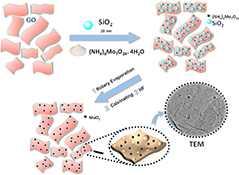
A novel MoO2 composite supported on mesoporous graphene oxide (m-MoO2/GO) is successfully synthesised. The introduction of a mesoporous structure into GO sheets not only promotes the catalytic activity, but also makes m-MoO2/GO more effective in catalysing olefins with a long carbon chain and large ring size.
CH17021Preparation and Photophysical Properties of All-trans Acceptor–π-Donor (Acceptor) Compounds Possessing Obvious Solvatochromic Effects
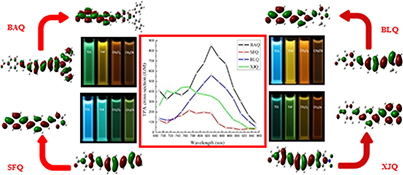
A series of all-trans acceptor–π-donor (acceptor) compounds were conveniently synthesised via the three-step synthetic method Arbuzov reaction, solvent-free Horner–Wadsworth–Emmons reaction, and Mizoroki–Heck reaction. They all exhibit obvious solvatochromic effects, strong two-photon excited fluorescence, and large two-photon absorption cross-sections.
CH17062Effects of Gold Nanoparticles and Gold Anti-Arthritic Compounds on Inflammation Marker Expression in Macrophages
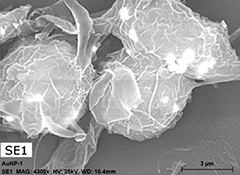
The ability of gold anti-arthritic agents and gold nanoparticles to alter production in RAW264.7 macrophages of a number of cellular mediators of inflammation, including reactive oxygen and nitrogen species, interleukin-10 and tumour necrosis factor, have been compared.



